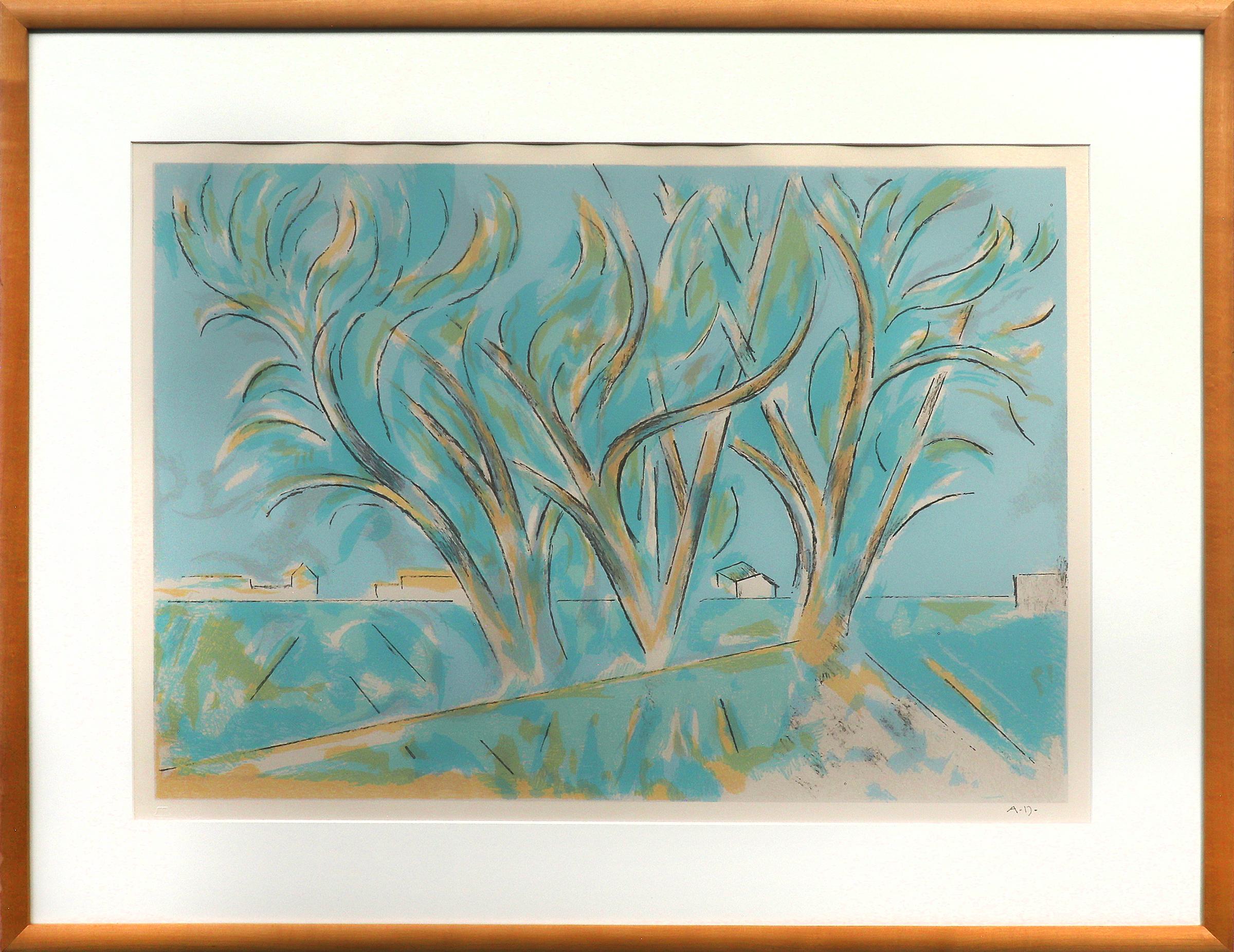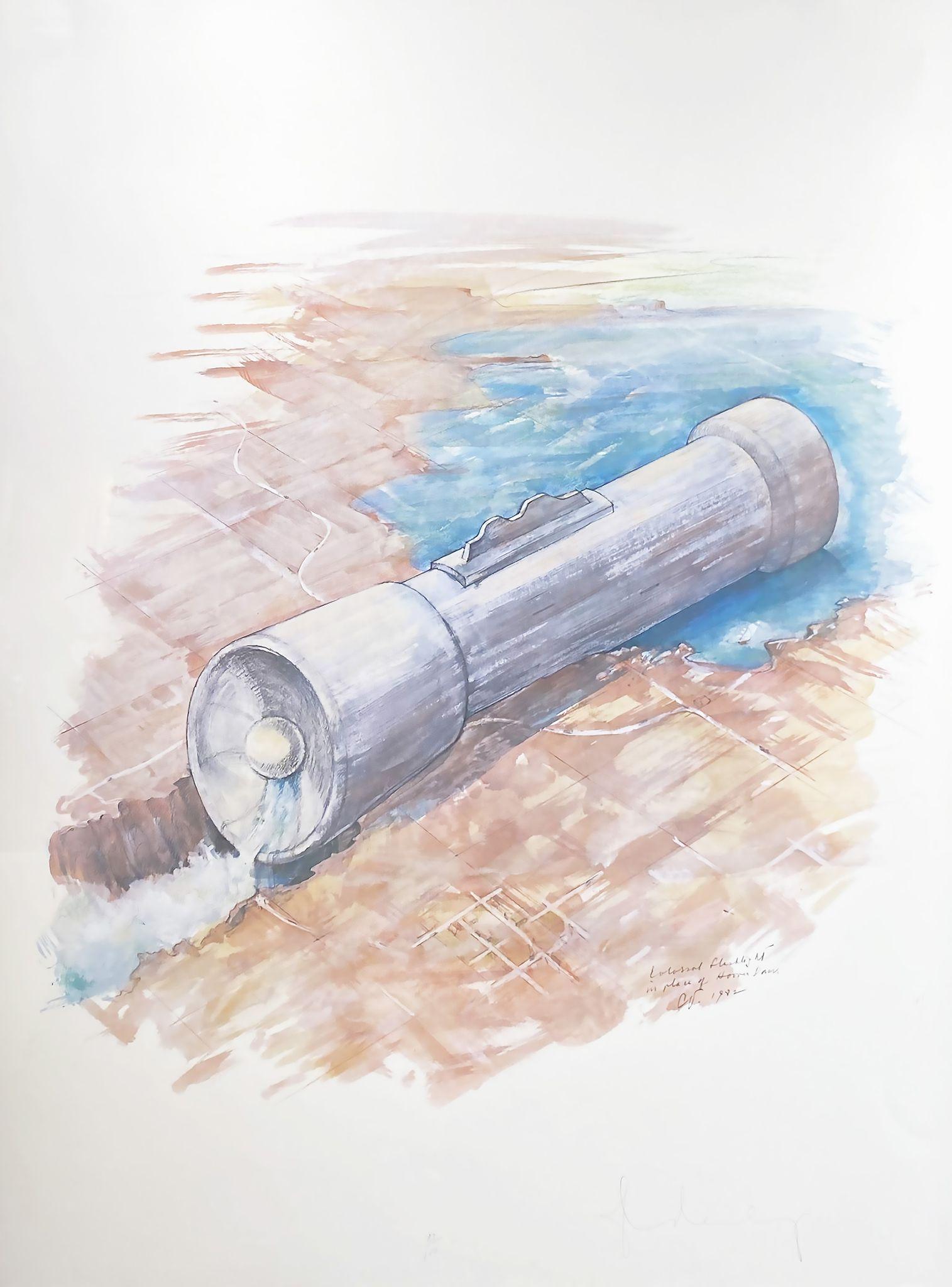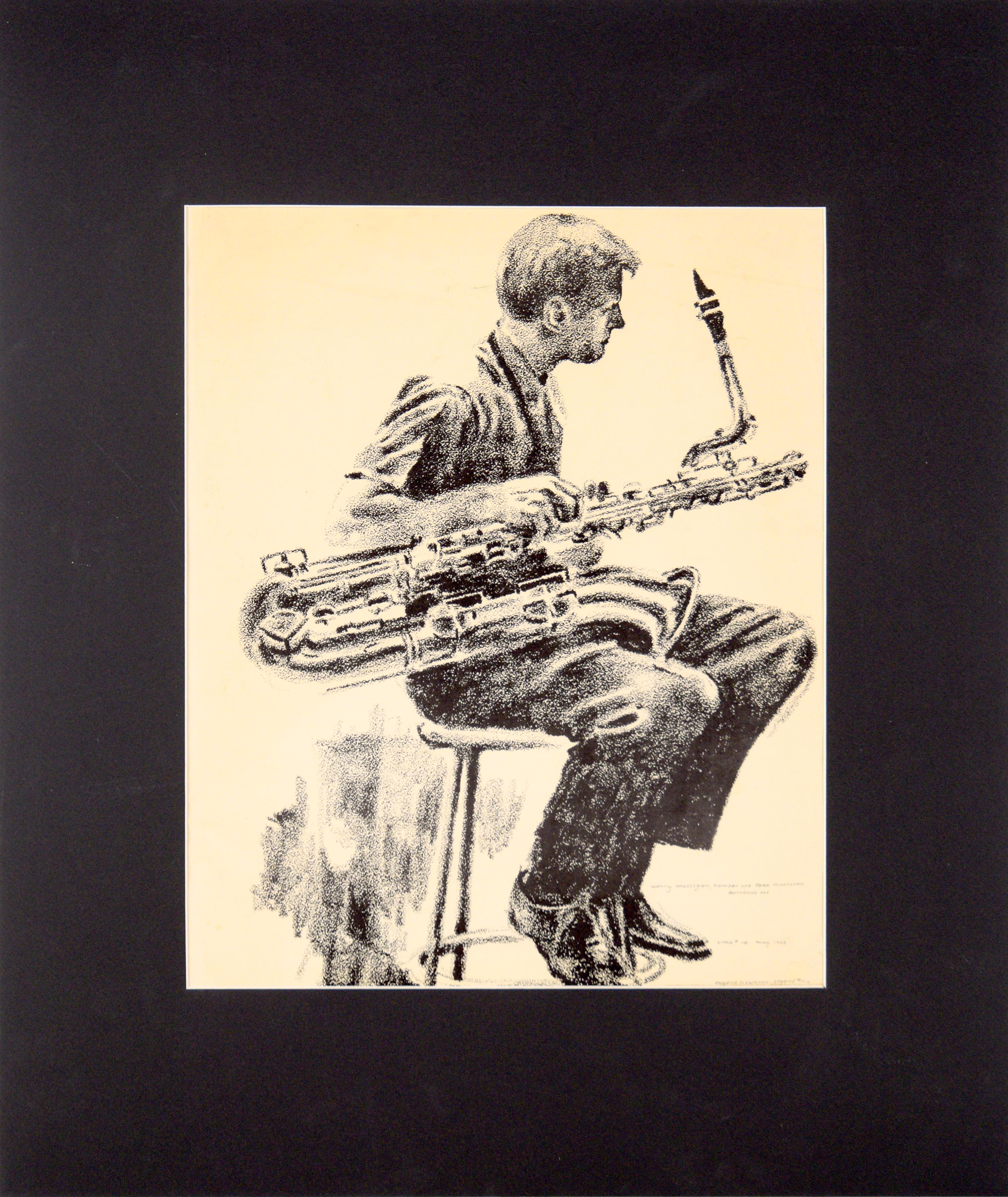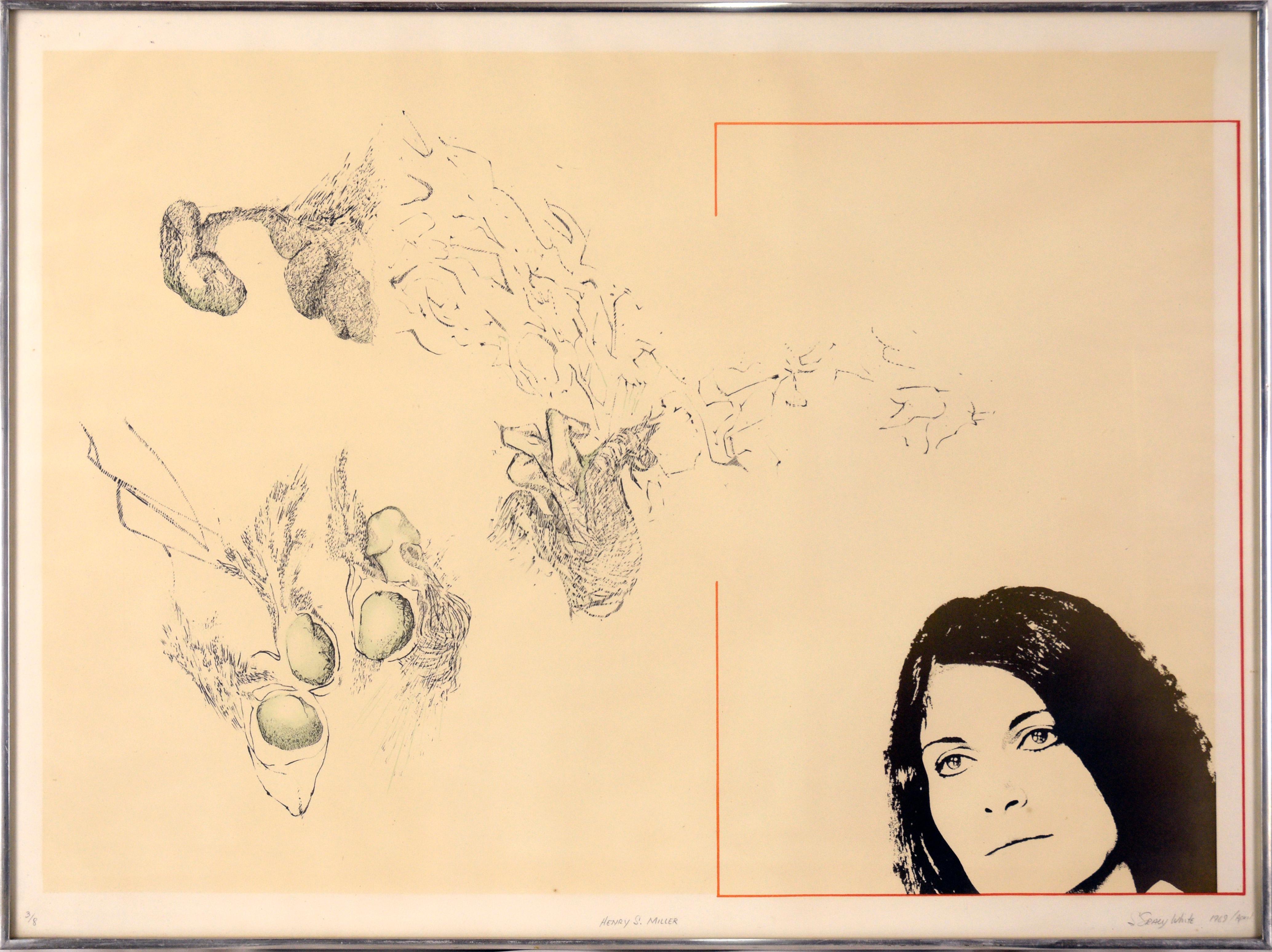Items Similar to Douglas Semivan Abstract Modern "Receiver I" Signed and Numbered
Want more images or videos?
Request additional images or videos from the seller
1 of 8
Douglas SemivanDouglas Semivan Abstract Modern "Receiver I" Signed and Numbered1980 - 1990s
1980 - 1990s
About the Item
SALE ONE WEEK ONLY
"Receiver I" is an abstract print of three diagonally placed lines. It is reminiscent of an early work by Georgia O'Keeffe, "Blue Lines X" in that both artists, Semivan and O'Keeffe, have achieved a beauty in the placement, width of, length and juxtapositions of simple lines to achieve a never ending balance and harmony for the viewer.
Born in Detroit, Michigan, Douglas Semivan is an artist and retired education who is Professor Emeritus of the Art Department at Madonna University in Livonia, Michigan.
Semivan’s work resides in the permanent collections of several museums: including the Museum of Modern Art, New York, the Detroit Institute of Arts, The Brooklyn Museum, The Toledo Museum of Art, and the Grand Rapids Art Museum. His works are also part of the collections of several corporations: The Ford Motor Copany, William Beaumont Hospital, City National Bank, IBM Corporation, and The Max Factor headquarters in North Carolina.
Semivan was visiting artist at the University of Wisconsin in Madison, WI, Western Michigan University in Kalamazoo, Michigan, Cornish College of the Arts in Seattle, Washington, and Olivet College in Olivet, Michigan.
He received his MFA in Printmaking from The Cranbrook Academy of Art in 1973, and a BA in Art from Olivet College in Olivet, Michigan in 1971. He has taught Lithography at Vancouver School of Art and Wayne State University and was Director of the Detroit Artists Market in Detroit, Michigan.
Semivan's alma mater, The Cranbrook Academy of Art in Bloomfield Hills, Michigan, was designed by architect and faculty member, Eliel Saarinen who collaborated with Charles and Ray Eames on chair and furniture design. Numerous creative artists who are alumni of Cranbrook include: Harry Bertoia, Florence Knoll, Jack Lenor Larsen, Donald Lipski, Duane Hanson, Nick Cave, Hani Rashid, George Nelson, Urban Jupena (Nationally recognized fiber artist), Artis Lane (the first African-American artist to have her sculpture, "Sojourner Truth," commissioned for the Emancipation Hall in the Capital Visitor Center in Washington DC), Cory Puhlman (televised Pastry Chef extraordinaire), Thom O’Connor (Lithographs), Paul Evans (Brutalist-inspired sculpted metal furnishings), Eugene Caples (small bronze images/abstract), Morris Brose (Bronze Sculptures), Herb Babcock (blown glass) and Larry Butcher (mixed media.)
He has a studio and resides in Royal Oak, Michigan. Measurements for print without frame: 19" h x 12.50 " w. This piece is signed and number 7 of 7.
- Creator:Douglas Semivan (1949)
- Creation Year:1980 - 1990s
- Dimensions:Height: 29 in (73.66 cm)Width: 21 in (53.34 cm)
- Medium:
- Movement & Style:
- Period:
- Condition:
- Gallery Location:Detroit, MI
- Reference Number:1stDibs: LU128616084202
About the Seller
5.0
Vetted Seller
These experienced sellers undergo a comprehensive evaluation by our team of in-house experts.
Established in 2014
1stDibs seller since 2019
97 sales on 1stDibs
Typical response time: 3 hours
- ShippingRetrieving quote...Ships From: Detroit, MI
- Return PolicyA return for this item may be initiated within 14 days of delivery.
More From This SellerView All
- Douglas Semivan Print "Abstract in Gold and Black"By Douglas SemivanLocated in Detroit, MISALE ONE WEEK ONLY "Abstract in Gold and Black" is a well-balanced calm piece. The placement of the gold and white can be read as a distant landscape giving much imagined space to the heavier black area which contains a linear element and the color blue. Semivan is a Master Printmaker and sculptor. He often breaks his surfaces and extends beyond the perimeters in his sculptures. The particular placement of the black area in this piece suggests such a breakage beyond the edge where one imagines a continuation of the strokes or linear elements. This is an altogether extraordinary print. Born in Detroit, Michigan, Douglas Semivan...Category
Late 20th Century American Modern Abstract Prints
MaterialsPaper, Printer's Ink
- "Indianapolis Museum of Art Inaugural Exhibitions", Color Silkscreen, SignedBy Robert IndianaLocated in Detroit, MI"Indianapolis Museum of Art Inaugural Exhibitions", 25 October 1970, is an eye popping large bold colorful geometric abstract silk screen. It is signed on the lower right. Robert Indiana, one of the preeminent figures in American art since the 1960s, played a central role in the development of assemblage art, hard-edge painting, Pop art, Neo-Dada, American Modernism and Modern Art. A self-proclaimed “American painter of signs,” Indiana created a highly original body of work that explores American identity, personal history, and the power of abstraction and language, establishing an important legacy that resonates in the work of many contemporary artists such as Andy Warhol, Keith Haring, Roy Lectenstein, David Hockney, Romero Britto, Richard Hamilton and Robert Rauschenberg who make the written word a central element of their oeuvre. Robert Indiana was born Robert Clark in New Castle, Indiana on September 13, 1928. Adopted as an infant, he spent his childhood moving frequently throughout his namesake state. At 14 he moved to Indianapolis in order to attend Arsenal Technical High School, known for its strong arts curriculum. After graduating he spent three years in the U.S. Air Force and then studied at the Art Institute of Chicago, the Skowhegan School of Sculpture and Painting in Maine, and the Edinburgh College of Art in Scotland. In 1956, two years after moving to New York, Indiana met Ellsworth Kelly, and upon his recommendation took up residence in Coenties Slip, where a community of artists that would come to include Kelly, Agnes Martin, James Rosenquist, and Jack Youngerman had studios. Indiana, like some of his fellow artists, scavenged the area’s abandoned warehouses for materials, creating sculptural assemblages from old wooden beams, rusted metal wheels, and other remnants of the shipping trade that had thrived in Coenties Slip. The discovery of 19th century brass stencils led to the incorporation of brightly colored numbers and short emotionally charged words onto these sculptures as well as canvases, and became the basis of his new painterly vocabulary. Although acknowledged as a leader of Pop, Indiana distinguished himself from his Pop peers by addressing important social and political issues and incorporating profound historical and literary references into his works. In 1964 Indiana accepted Philip Johnson’s invitation to design a new work for the New York State Pavilion at the New York World’s Fair, creating a 20-foot EAT sign...Category
1970s American Modern Abstract Prints
MaterialsPaper, Ink, Screen
- Joyce T. Nagel Print "Orange" AP 1 Artist's Proof Handmade Paper Signed DatedLocated in Detroit, MI"Orange" is marked AP 1 meaning it was the print pulled and approved by the artist before additional prints were made. It is a colorful and lively abstract arrangement of circles and squares and printed on hand-made paper. Joyce Tilley Nagel...Category
1970s Modern Abstract Prints
MaterialsInk, Paper
- Helen Frankenthaler What Red Lines Can Do Series, Screen PrintBy Helen FrankenthalerLocated in Detroit, MIONE WEEK ONLY SALE "Untitled" lithograph from Frakenthaler's What Red Lines Can Do Series. Signed and dated, with the numbers 55/9/75 on the lower front right. Color screen print on white arches handmade cold press paper. Helen Frankenthaler was born on December 12, 1928 in New York City, the daughter of a New York Supreme Court judge and a family of Jewish immigrants from Germany who emphasized culture and intellectual pursuits and continue to be active to this day such as through nephew, the artist and photographer Clifford...Category
1970s Abstract Expressionist Abstract Prints
MaterialsLithograph
- Roy Lichtenstein "Figures" 1978 (From Surrealist Series) Gemini G.E.L. PrintersBy Roy LichtensteinLocated in Detroit, MISALE ONE WEEK ONLY Title: Figures Portfolio: 1978 Surrealist Medium: Lithograph on Arches 88 paper Edition: 38 Sheet Size: 31 7/16" x 23 1/2" Image Size: 23 1/2" x 15 1/4" Signature: Hand signed in pencil Reference: Corlett 156 Printed by Gemini G.E.L. printers out of Los Angeles. Roy Fox Lichtenstein was an American pop artist. During the 1960s through the 90’s, along with Andy Warhol, Jasper Johns, and James Rosenquist, he became a leading figure in the new art movement. His work defined the premise of pop art through parody. Most of Lichtenstein's best-known works are relatively close, but not exact, copies of comic book panels, a subject he largely abandoned in 1965. Lichtenstein's Still Life paintings, sculptures and drawings, which span from 1972 through the early 1980s, cover a variety of motifs and themes, including the most traditional such as fruit, flowers, and vases. Inspired by the comic strip, Lichtenstein produced precise compositions that documented while they parodied, often in a tongue-in cheek manner. His work was influenced by popular advertising and the comic book style. His artwork was considered to be "disruptive". He described pop art as "not 'American' painting but actually industrial painting". His paintings were exhibited at the Leo Castelli Gallery in New York City. Wham!, and Drowning Girl Look Mickey proved to be his most influential works. His most expensive piece is Masterpiece which was sold for $165 million in January 2017. Lichtenstein received both his Bachelors and Masters at Ohio State University, Columbus, Ohio where he taught for ten years. In 1967, he moved back to upstate New York and began teaching again. It was at this time that he adopted the Abstract Expressionist style, being a late convert to this style of painting. Lichtenstein began teaching in upstate New York at the State University of New York at Oswego in 1958. About this time, he began to incorporate hidden images of cartoon characters such as Mickey Mouse and Bugs Bunny into is abstract works. In 1960, he started teaching at Rutgers University where he was heavily influenced by Allan Kaprow, who was also a teacher at the university. This environment helped reignite his interest in Proto-pop imagery. In 1961, Lichtenstein began his first pop paintings using cartoon images and techniques derived from the appearance of commercial printing. This phase would continue to 1965, and included the use of advertising imagery suggesting consumerism and homemaking. His first work to feature the large-scale use of hard-edged figures and Ben-Day dots was Look Mickey (1961), National Gallery of Art, Washington, D. C.) This piece came from a challenge from one of his sons, who pointed to a Mickey Mouse comic book and said; "I bet you can't paint as good as that, eh, Dad?" In the same year he produced six other works with recognizable characters from gum wrappers and cartoons. It was at this time that Lichtenstein began to find fame not just in America but worldwide. He moved back to New York to be at the center of the art scene in 1964 to concentrate on his painting. Lichtenstein used oil and Magna (early acrylic) paint in his best known works, such as Drowning Girl (1963), which was appropriated from the lead story in DC Comics’ Secret Hearts No. 83, drawn by Tony Abruzzo. (Drowning Girl now hangs in the Museum of Modern Art, New York.) Drowning Girl also features thick outlines, bold colors and Ben-Day dots, as if created by photographic reproduction. Of his own work Lichtenstein would say that the Abstract Expressionists "put things down on the canvas and responded to what they had done, to the color positions and sizes. My style looks completely different, but the nature of putting down lines pretty much is the same; mine just don't come out looking calligraphic, like Pollock’s or Kline’s. Rather than attempt to reproduce his subjects, Lichtenstein's work tackled the way in which the mass media portrays them. He would never take himself too seriously, however, saying: "I think my work is different from comic strips – but I wouldn't call it transformation; I don't think that whatever is meant by it is important to art.” When Lichtenstein's work was first exhibited, many art critics of the time challenged its originality. His work was harshly criticized as vulgar and empty. The title of a Life magazine article in 1964 asked, "Is He the Worst Artist in the U.S.?" Lichtenstein responded to such claims by offering responses such as the following: "The closer my work is to the original, the more threatening and critical the content. However, my work is entirely transformed in that my purpose and perception are entirely different. I think my paintings are critically transformed, but it would be difficult to prove it by any rational line of argument.” In 1969, Lichtenstein was commissioned by Gunter Sachs to create Composition and Leda and the Swan, for the collector's Pop Art bedroom suite at the Palace Hotel in St. Moritz. In the late 1970s and during the 1980s, Lichtenstein received major commissions for works in public places: the sculptures Lamp (1978) in St. Mary's, Georgia; Mermaid (1979) in Miami Beach; the 26 feet tall Brushstrokes in Flight (1984, moved in 1998) at John Glenn Columbus International Airport; the five-storey high Mural with Blue Brushstroke (1984–85) at the Equitable Center, New York and El Cap de Barcelona (1992) in Barcelona. In 1994, Lichtenstein created the 53-foot-long, enamel-on-metal Times Square Mural in Times Square subway station. In 1977, he was commissioned by BMW to paint a Group 5 Racing Version of the BMW 320i for the third installment in the BMW Art Car Project. The DreamWorks Records logo was his last completed project. "I'm not in the business of doing anything like that (a corporate logo) and don't intend to do it again," allows Lichtenstein. "But I know Mo Ostin and David Geffen and it seemed interesting. In 1996 the The National Gallery of Art in Washington, D.C. became the largest single repository of the artist's work when Lichtenstein donated 154 prints and 2 books. The Art Institute of Chicago has several important works by Lichtenstein in its permanent collection, including Brushstroke with Spatter (1966) and Mirror No. 3 (Six Panels) (1971). The personal holdings of Lichtenstein's widow, Dorothy Lichtenstein, and of the Roy Lichtenstein Foundation number in the hundreds. In Europe, the Museum Ludwig in Cologne has one of the most comprehensive Lichtenstein holdings with Takka Takka (1962), Nurse (1964), Compositions I (1964), besides the Frankfurt Museum fur Modern Kunst with We Rose Up slowly (1964), and Yellow and Green Brushstrokes...Category
1970s Pop Art Abstract Prints
MaterialsLithograph
- Lance Lawlor Lithograph "Design in Black & White" Geometric AbstractLocated in Detroit, MI"Design in Black & White" is a lithograph by the well-known Michigan designer Lance Lawlor. He was a Master of linear and decorative design and this print displays the talent for which he was sought after. Lance Stephen Lawlor was born January 6, 1955, in Detroit, Michigan. He attended the University of Michigan, graduating with a BFA in 1975 from the Penny W. Stamps School of Art & Design. He was a student of world renown costume designers of the 1930s-1950s, especially Adrian Adolph...Category
1990s Contemporary Abstract Prints
MaterialsLithograph
You May Also Like
- Trees in Ranchitos II, New Mexico, 1970s Color Lithograph Landscape with TreesBy Andrew Michael DasburgLocated in Denver, CO"Tree in Ranchitos II" (New Mexico) is a lithograph initialed lower right by artist Andrew Michael Dasburg (1887-1979) from 1975. Presented in a custom frame measuring 30 ½ x 36 ¼ inches. Image size is 16 ½ x 23 ¼ inches. About the Artist: Born France, 1887 Died New Mexico, 1979 Andrew Dasburg was born in Paris, but emigrated to New York City in 1892 with his mother. A childhood sickness left him lame, and his artistic propensities were first recognized by a teacher at the crippled children’s school. She enrolled him in the Art Students League in 1902. There he studied under Kenyon Cox, Frank Vincent Dumond, and Birge Harrison. Later, he began taking night classes from Robert Henri at the New York School of Art. Dasburg spent 1908-1910 in Paris, where he was introduced to the great impressionist painters Matisse and Cezanne. Inspired by the work of the European modernists, Dasburg returned to the United States, where he moved to Woodstock, New York. In Woodstock, he and his wife, Grace Mott Johnson, lived with Morgan Russell...Category
1970s American Modern Landscape Prints
MaterialsLithograph, Archival Paper
- Colossal Flashlight in Place of Hoover DamBy Claes OldenburgLocated in Missouri, MOColossal Flashlight in Place of Hoover Dam, 1982 By Claes Oldenburg (Swedish, American, 1929-2022) Signed Lower Right Dated Middle Right Unframed: 23" x 22" Framed: 36.5" x 27.5" Whimsical sculpture of pop culture objects, many of them large and out-of-doors, is the signature work of Swedish-born Claes Oldenburg who became one of America's leading Pop Artists. He was born in Stockholm, Sweden. His father was a diplomat, and during Claes' childhood moved his family from Stockholm to a variety of locations including Chicago where the father was general consul of Sweden and where Oldenburg spent most of his childhood. He attended the Latin School of Chicago, and then Yale University where he studied literature and art history, graduating in 1950, the same year Claes became an American citizen. Returning to Chicago, he enrolled at the Art Institute of Chicago from 1952 to 1954 and also worked as a reporter at the City News Bureau. He opened his own studio, and in 1953, some of his satirical drawings were included in his first group show at the Club St. Elmo, Chicago. He also painted at the Oxbow School of Painting in Michigan. In 1956, he moved to New York where he drew and painted while working as a clerk in the art libraries of Cooper-Union Museum for the Arts of Decoration. Selling his first artworks during this time, he earned 25 dollars for five pieces. Oldenburg became friends with numerous artists including Jim Dine, Red Grooms and Allan Kaprow, who with his "Happenings" was especially influential on Oldenburg's interest in environmental art. Another growing interest was soft sculpture, and in 1957, he created a piece later titled Sausage, a free-hanging woman's stocking stuffed with newspaper. In 1959, he had his first one-man show, held at the Judson Gallery at Washington Square. He exhibited wood and newspaper sculpture and painted papier-mache objects. Some viewers of the exhibit commented how refreshing Oldenburg's pieces were in contrast to the Abstract Expressionism, a style which much dominated the art world. During this time, he was influenced by the whimsical work of French artist, Bernard Buffet, and he experimented with materials and images of the junk-filled streets of New York. In 1960, Oldenburg created his first Pop-Art Environments and Happenings in a mock store full of plaster objects. He also did Performances with a cast of colleagues including artists Lucas Samaras, Tom Wesselman, Carolee Schneemann, Oyvind Fahlstrom and Richard Artschwager, dealer Annina Nosei, critic Barbara Rose, and screenwriter Rudy Wurlitzer. His first wife (1960-1970) Pat Muschinski, who sewed many of his early soft sculptures, was a constant performer in his Happenings. This brash, often humorous, approach to art was at great odds with the prevailing sensibility that, by its nature, art dealt with "profound" expressions or ideas. In December 1961, he rented a store on Manhattan's Lower East Side to house "The Store," a month-long installation he had first presented at the Martha Jackson Gallery in New York. This installation was stocked with sculptures roughly in the form of consumer goods. Oldenburg moved to Los Angeles in 1963 "because it was the most opposite thing to New York I could think of". That same year, he conceived AUT OBO DYS, performed in the parking lot of the American Institute of Aeronautics and Astronautics in December 1963. In 1965 he turned his attention to drawings and projects for imaginary outdoor monuments. Initially these monuments took the form of small collages such as a crayon image of a fat, fuzzy teddy bear looming over the grassy fields of New York's Central Park (1965) and Lipsticks in Piccadilly Circus, London (1966). Oldenburg realized his first outdoor public monument in 1967; Placid Civic Monument took the form of a Conceptual performance/action behind the Metropolitan Museum of Art, New York, with a crew of gravediggers digging a 6-by-3-foot rectangular hole in the ground. Many of Oldenburg's large-scale sculptures of mundane objects elicited public ridicule before being embraced as whimsical, insightful, and fun additions to public outdoor art. From the early 1970s Oldenburg concentrated almost exclusively on public commissions. Between 1969 and 1977 Oldenburg had been in a relationship with Hannah Wilke, feminist artist, but in 1977 he married Coosje van Bruggen, a Dutch-American writer and art historian who became collaborator with him on his artwork. He had met her in 1970, when she curated an exhibition for him at the Stedelijk Museum in Amsterdam. Their first collaboration came when Oldenburg was commissioned to rework Trowel I, a 1971 sculpture of an oversize garden tool, for the grounds of the Kröller-Müller Museum in Otterlo, the Netherlands. Oldenburg has officially signed all the work he has done since 1981 with both his own name and van Bruggen's. In 1988, the two created the iconic Spoonbridge and Cherry sculpture for the Walker Art Center in Minneapolis, Minnesota that remains a staple of the Minneapolis Sculpture Garden as well as a classic image of the city. Typewriter Eraser...Category
20th Century American Modern Abstract Prints
MaterialsPaper, Lithograph
- Gerry Mulligan, Baritone Sax - Rare Signed Figurative Lithograph in Ink on PaperLocated in Soquel, CAGerry Mulligan, Baritone Sax - Rare Signed Figurative Lithograph in Ink on Paper Bold lithograph by Eugene Hawkins (American, b. 1933). Gerry Mulligan sits on a stool holding his ba...Category
1960s American Modern Figurative Prints
MaterialsPaper, Ink, Lithograph
- "Henry S. Miller" Lithograph in Ink on Paper, #3 of 8Located in Soquel, CA"Henry S. Miller" Lithograph in Ink on Paper, #3 of 8 Surrealist lithograph by Stephen Tracy White (American, 1947-2005). A figure in the lower right corner is partially enclosed by a red rectangle. Biomorphic shapes are flowing out of the rectangle, stretching across the composition. The shapes are rendered with intricate linework and soft green shading. Numbered, titled, signed, and dated along the bottom: 3/8 Henry S. Miller S. Tracy White 1969/April Tag on verso from Lee Nordness Galleries, New York Presented in a silver aluminum frame. Shipped without glass. Frame size: 26.5"H x 36.25"W Image size: 23.5"H x 34.25"W Stephen Tracy White (American, 1947-2005) was born in Bronwood, Georgia. They studied at the University of New Mexico, earning a Bachelor of Fine Arts in Art in 1969. They worked at the Tamarind Lithography Workshop, printing pieces by William Crutchfield...Category
1960s American Modern Portrait Prints
MaterialsPaper, Ink, Lithograph
- 1950s "Abstract Line Print" Stone Lithograph San Francisco PrintmakerLocated in Arp, TXFrom the estate of Jerry Opper and Ruth Opper Abstract Line Print c.1950's Stone Lithograph on Paper 25" x 19.5" Unframed Estate stamp lower left Came from ...Category
Mid-20th Century American Modern Abstract Prints
MaterialsPaper, Lithograph
- Orofena, from Imaginary Places IIIBy Frank StellaLocated in London, GBLithograph, screenprint, etching and aquatint printed in colours, with relief, 1998, signed in pencil, dated, numbered from the edition of 55 (there were also 14 artist's proofs), with the publisher's blindstamp, Tyler Graphics, Ltd., Mount Kisco, 54.6 x 55.2 cm. (21½ x 21¾ in.) Catalogue Raisonne: Axsom 252 Over a period of four years, Stella created a body of prints whose titles all came from ‘The Dictionary of Imaginary Places’ by Alberto Mangual and Gianni Guadalupi. Each work from this series is recognisable for its teaming compositions of twisting, colliding and knotted forms. The shapes appear to spill out of their sheet, seemingly trying to escape their frames. As he had done since the ‘Swan Engravings...Category
1990s American Modern Abstract Prints
MaterialsEtching, Aquatint, Lithograph, Screen
Recently Viewed
View AllMore Ways To Browse
Number 7
19 Number
Vintage American Metal Signs
Vintage Metal Number Signs
Retro Modern Furnishings
Vintage Herb Signs
Modern Mates
Used Receivers
Vintage Motor Signs
Michigan Lithograph
Vintage Douglas Furniture
Royal Oak Vintage
George Hall Chairs
Brutalist Metal Chair
Early Georgian George I
Bertoia Metal Sculpture
Cranbrook Saarinen
Bronze Bertoia





